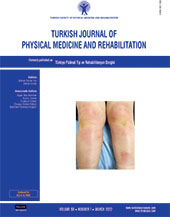The levels of 25-hydroxy vitamin D, parathyroid hormone, calcitonin and lipid profiles in patients with calcaneal spur
2 Department of Biochemisty, Van Yüzüncü Yıl University, Van, Turkey DOI : 10.5606/tftrd.2022.6799 Objectives: The aim of this study was to investigate the 25-hydroxyvitamin D (25(OH)D), parathyroid hormone (PTH), and calcitonin levels and lipid profiles in patients with calcaneal spurs.
Patients and methods: Between March 2018 and June 2019, a total of 50 patients (30 males, 20 females; mean age: 39.8±8.1 years; range, 24 to 54 years) admitted to our clinic with heel pain and diagnosed with heel spurs based on radiographic images were included. The control group consisted of 50 age- and sex-matched healthy volunteers (32 males, 18 females; mean age: 35.7±9.6 years; range, 20 to 56 years). Blood samples were collected from all participants. Total cholesterol, high-density lipoprotein cholesterol (HDL-C), low-density lipoprotein cholesterol (LDL-C), triglyceride, phosphate, and calcium levels were measured using the colorimetric method. The PTH and 25(OH)D levels were measured using the chemiluminescent microparticle immunoassay. Calcitonin levels were detected using the chemiluminescent immunometric assay.
Results: In the patients with calcaneal spurs, 25(OH)D and HDL-C levels were significantly lower (p<0.001), while LDL-C, triglyceride, and PTH levels were significantly higher (p<0.05, p<0.002 and p<0.001, respectively). There was no significant difference in the calcium, phosphate, body mass index, and calcitonin levels between the groups.
Conclusion: Our study results suggest that calcaneal spur formation is associated not only with weight-related pressure, but also with lipid levels and hormonal alterations involved in calcium metabolism. Based on these findings, hormonal alterations and lipids should be considered in patients with calcaneal spurs.
Keywords : 25-hydroxy vitamin D, calcaneal spur, calcium, heel spur, lipid profile, parathyroid hormone
















